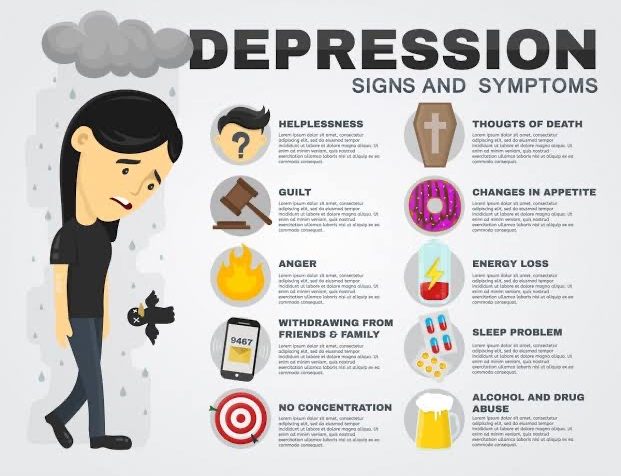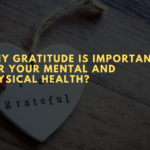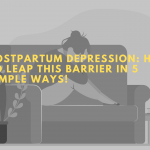Want to know about the different types of depression & it’s symptoms??
Ever thought about what are the types of depression & it’s symptoms and how can you identify them in humans??
What Depression is?
A group of conditions associated with the elevation or lowering of a person’s mood, such as depression or bipolar disorder.
Depression is a worldwide common condition, affecting over 264 million individuals. Depression varies from natural changes in mood and short-term emotional reactions to daily problems.
Depression may become a serious disorder particularly if it is long-lasting and mild to extreme.
It can lead to considerable distress and low functioning on the job, at school, and in the home. Depression can lead to suicide at its worst.
Per year, almost 800 000 individuals die from suicide. In 15-29-year-olds, suicide is the second leading cause of death.
Read on to learn about some of the more common types of depression.
Some Key Facts about Depression:
- Depression is a widespread psychiatric condition. About 264 million persons globally experience depression at all ages.
- Depression is one of the world’s leading disability factors and adds significantly to the worldwide disease burden.
- Many women than men suffer from depression.
- Depression leads to suicide.
- Low to extreme depression is successfully treated clinically and pharmacologically.
Types Of Depression & It’s Symptoms
A depression episode may be graded as mild, moderate, or extreme based on the amount and severity of the symptoms. The following includes seven of the most prominent forms of depression.
- Major Depressive Disorder:
A major depressive disorder is a classical type of depression. When individuals use the term psychiatric or clinical depression, they usually refer to major depressive disorder (MDD)
Most people at some point in their life feel depressed or low. Clinical depression, however, is characterized by a depressive mood most of the day, often particularly in the morning, and a lack of interest in daily activities and relationships—symptoms that have been present every day for at least 2 weeks.
In comparison, according to the DSM-5—a textbook used to diagnose mental wellbeing conditions—you may have other effects of severe depression.
Symptoms:
- Sadness, Hollow Thoughts
- Loss of fun of hobbies, jobs, other things
- Changes of desire, weight loss, or gain
- Sleeping trouble (too much or too little)
- Feeling “slowed down” or becoming unnecessarily irritated
- Tiredness, tiredness, loss of resources
- Physical signs and discomfort (such as body aches, stomach upset, headaches)
- Feelings of worthlessness or shame
- Concentration or Concentrating Issues
- Inability to take action or bad decision-making
- Thinking about death or dying; planning or trying to commit suicide;
The major depressive disorder tends to be more prevalent in women and those between the ages of 18 and 25.
Treatment:
MDD is however treated with medications and psychotherapy. Any lifestyle changes can also help to relieve those symptoms.
People who have serious MDDs or who have thoughts of hurting themselves may need to remain in the hospital during recovery. Some will also continue to take part in an outpatient recovery program before conditions change.
- Medication: Primary care providers frequently begin MDD therapy by recommending antidepressant drugs.
Selective serotonin reuptake inhibitors (SSRIs) are a commonly used form of antidepressant.SSRIs include well-known drugs such as fluoxetine (Prozac) and citalopram (Celexa).
Tricyclic antidepressants and medications known as atypical antidepressants, such as bupropion (Wellbutrin), may be used when other drugs haven’t helped.
- Psychotherapy Treatment: Psychotherapy, can be an important treatment for people with MDD. It includes seeing a psychiatrist daily to discuss the illness and associated problems.
Psychotherapy can help you adjust to a crisis or other stressful event. It can also help you replace negative beliefs and behaviors with positive, healthy ones.
- Lifestyle changes: In addition to avoiding drugs and taking part in treatment, you can help strengthen the effects of MDD by making certain improvements to your everyday activities.
- Persistent depressive disorder(PDD):
A form of chronic (ongoing) depression is a persistent depressive disorder. While chronic depressive disorder symptoms can be less severe than other forms of depression, their period is longer.
A recent update to the Diagnostic and Statistical Manual of Mental Disorders, Fifth Edition (DSM-5) is a consolidation of two previous diagnoses: chronic major depressive episode and dysthymic disorder, the standard reference manual used for the diagnosis of known mental conditions in the United States.
Symptoms:
Symptoms of chronic depressive disorder, while not as severe as those of major depression, also require the involvement of two (or more) of the following:
- Hopelessness emotions
- Poor self-esteem for oneself
- Poor energy or exhaustion
- Overeating or low appetite
- Concentration and decision-making challenges
- Difficulty falling or remaining asleep or sleeping too long (insomnia) (hypersomnia)
Individuals with the persistent depressive disorder frequently have a pessimistic outlook about themselves, their future, those around them, and events in general life.
Treatment:
Treatment for PDD consists of medication and talk therapy. When taken individually, medicine is known to be a more successful method of care than talk therapy. However, a combination of medication and talk therapy is often the best course of treatment.
- Medication: PDD may be treated with antidepressants of different forms, including:
- Selective antagonists of serotonin reuptake (SSRI), such as fluoxetine (Prozac) and sertraline (Zoloft)
- Tricyclic antidepressants (TCAs), such as amoxapine and amitriptyline (Elavil) (Asendin)
- Reuptake inhibitors of serotonin and norepinephrine (SNRIs), such as desvenlafaxine (Pristiq) and duloxetine (Cymbalta)
- Therapy: For certain individuals with PDD, talk therapy is a helpful recovery choice. Seeing a psychologist will help you learn how to:
- A positive way to express your feelings and emotions
- Dealing for your thoughts
- Adapt to a challenge or crisis in life
- Lifestyle change:
- Working out at least three days a week
- Eating a diet composed mainly of nutritious foods such as fruits and vegetables
- Abuse and drink prevention
- Having to see an acupuncturist
- Bipolar Disorder:
Bipolar disorder is a mental health disease that induces frequent mood swings that have emotional spikes (mania or hypomania) and lows, previously referred to as bipolar depression (depression).
You can feel miserable or desperate and lose enthusiasm or enjoyment in most things as you become depressed. You can feel euphoric, full of energy, or unusually irritable when the mood changes to mania or hypomania (less serious than mania).
Sleep, motivation, activity, judgment, actions, and the capacity to think objectively may be influenced by these mood swings.
Symptoms:
There are high moods in hypomania and mania. More intense than hypomania, Mania is.
Symptoms might include:
- Judgment impaired
- Weird Feeling
- Getting no sleep but not feeling exhausted
- A sense of boredom or diversion
- Lack of work or education
- Underperforming in school or at work
- Feeling capable of doing something
- Being sociable and forthcoming, too violently even,
- Being embroiled in dangerous actions
- Heightened libido
Treatment:
Treatment helps to stabilize the mood of the client and decrease the severity of symptoms. The aim is to allow the person to work efficiently in everyday life.
A combination of treatments requires therapy, including:
- Medicines
- Therapy
- Physical Behavior
- Remedies for Lifestyles
- As people respond differently, and symptoms vary greatly, it may take time to get the right diagnosis and find an appropriate cure.
- Bipolar II Disorder:
Bipolar II disorder (pronounced “bipolar two”) is a form of mental illness. With moods cycling from high and low over time, bipolar II is equivalent to bipolar I disorder.
However, the “up” moods never hit full-blown mania in bipolar II disorder. In bipolar II disorder, the less-intense high moods are called hypomanic phases, or hypomania.
In their lives, a person afflicted by bipolar II disorder has had at least one hypomanic episode. Many persons with bipolar II disorder suffer from periods of depression more frequently. This is where the term “manic depression” comes from.
Symptoms:
The elevated mood will manifest as either euphoria (feeling “high”) or as irritability during a hypomanic episode.
During hypomanic episodes, signs include:
- Flying from one proposal to the next unexpectedly
- Having inflated self-confidence
- Rapid, (uninterruptible) “pressured” and noisy voice
- Higher energy, hyperactivity, and a less need for sleep
- The sensation of becoming more creative
- To be more sociable, cocky, or sexually active
- Irritability
- Talking quicker and faster than normal,
- Drinking more beer or coffee
- To smoke more or to take more drugs
An individual with hypomania can feel good and perform well, but others may find that their acts are abnormal. There is a possibility that a depressive disorder will follow despite feeling healthy. A depressive episode’s symptoms can include:
- Losing interest in activities
- Getting too much or too little sleep
- Getting reduced amounts of energy
- Emotions of worthlessness and remorse
- Getting problems concentrating
- A sad, lonely, or hopeless feeling
- Having little motivation
Treatment:
A mixture of medicine and psychotherapy typically includes treatment for bipolar II disorder.
Typically, it is long-lasting and continuing. When a person stops medication, symptoms will return, including though they feel well.
- Medication: These may include:
- mood stabilizers
- antipsychotics
- antidepressants
- medications to help improve sleep quality
- Psychotherapy and counseling: It can help to speak about feelings and problems related to bipolar disorder. Psychotherapy or counseling may be directed at:
- Establish symptom coping techniques
- Identify effective ways of reducing stress
- Defining stimuli and ways to stop them
- Inform the patient of bipolar disorder
- Postpartum Depression:
Postpartum depression (PPD) is a dynamic combination of changes in physical, mental, and behavioral changes that arise after giving birth in certain people.
PPD is a type of major depression that occurs within 4 weeks after delivery, according to DSM-5, a textbook used to diagnose psychiatric disorders.
The diagnosis of postpartum depression is based on the severity of the depression, not just on the period between conception and onset.
Symptoms:
Postpartum depression symptoms range from person to person and also from day-to-day.
Chances are you’re familiar with some of these measures if you have postpartum depression:
- Though you don’t know why you feel depressed or sob a lot.
- You’re tired, but you’re not able to relax.
- You sleep so heavily.
- You can’t avoid eating, or you have no interest whatsoever in cooking.
- You have different aches, headaches, or unknown ailments.
- You have no idea whether you’re irritable, nervous, or crazy.
- Suddenly and without warning, the moods shift.
- You feel out of control.
- You’ve got trouble recalling things.
- You can’t focus or make easy choices.
- In stuff you used to love, you have little interest.
- You feel distant from your child and wonder why you are not as full of excitement as you thought you were going to be.
- It just sounds confusing and hopeless.
- With regards to your emotions, you feel useless and ashamed.
- You feel like you can’t open up to anyone or they’re going to think you’re a bad mother, or they’re going to take your kids, so you’re withdrawing.
- You want everyone and everything to leave.
- You have unwanted feelings about yourself or your baby being hurt.
Treatment:
You can visit the doctor as soon as possible if you have signs of postpartum depression so that you can begin recovery.
For postpartum depression, there are two primary treatments: medicine and rehabilitation. Either one may be used alone, but when used together, they can be more effective. In your everyday life, it’s also important to make some healthier decisions.
- Medication: Antidepressants affect the brain specifically. They change the mood-regulating chemicals. However, they won’t work right away. Before you feel a change in your attitude, it can take several weeks to take the prescription.
- Therapy: Counseling may be offered by a psychiatrist, psychologist, or another mental health specialist. Therapy will assist you to make sense of suicidal emotions and provide methods to move around them.
- Self-Care: This element of counseling can be a little tougher than it looks. Practicing self-care means cutting the slack on yourself.
You do not want to take more stress than you can deal with. Instinctively, people will not know what you need, so it’s necessary to remind them. Take some “me time,” just don’t get yourself separated. For new moms, try forming a community group.
Alcohol is a depressant, so you need to stay away from it. Offer your body every chance to recover, instead. Feed a well-balanced diet and have some regular exercise, even though it’s just a neighborhood stroll.
Conclusion:
For all, depression is not the same and even the symptoms differ from person to person. It ranges from a minor illness to a more severe one. With both forms of care, there is a treatment and, in most cases, the treatment shows good outcomes.
The outcome is very positive for suicidal persons who undergo help. You will take control of your life by working with a trained and knowledgeable mental health care provider.








